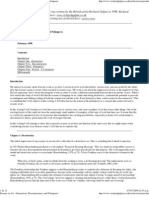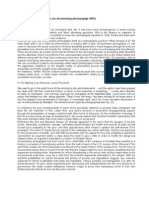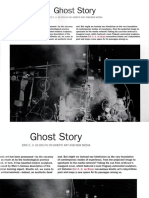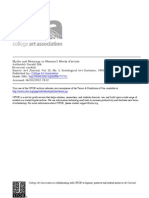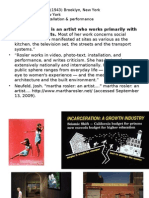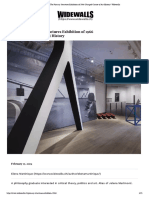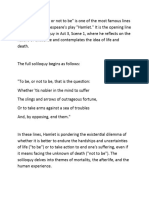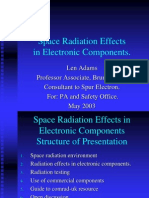Birnbaum
Birnbaum
Uploaded by
JamieCopyright:
Available Formats
Birnbaum
Birnbaum
Uploaded by
JamieCopyright
Available Formats
Share this document
Did you find this document useful?
Is this content inappropriate?
Copyright:
Available Formats
Birnbaum
Birnbaum
Uploaded by
JamieCopyright:
Available Formats
Dara Birnbaum
Author(s): Karen Kelley and Barbara Schröder
Source: BOMB , Summer, 2008, No. 104 (Summer, 2008), pp. 66-73
Published by: New Art Publications
Stable URL: https://www.jstor.org/stable/40427995
JSTOR is a not-for-profit service that helps scholars, researchers, and students discover, use, and build upon a wide
range of content in a trusted digital archive. We use information technology and tools to increase productivity and
facilitate new forms of scholarship. For more information about JSTOR, please contact support@jstor.org.
Your use of the JSTOR archive indicates your acceptance of the Terms & Conditions of Use, available at
https://about.jstor.org/terms
New Art Publications is collaborating with JSTOR to digitize, preserve and extend access to
BOMB
This content downloaded from
178.197.234.185 on Fri, 12 Nov 2021 17:11:52 UTC
All use subject to https://about.jstor.org/terms
l»^l;JU.I.MITni
I.M^Md.lL^lultl.l.lifeiaAllfeHJaBBHl
DARÀ BIRNBAUMS DECONSTRUCTIVE INVESTIGATION OF MASS-MEDIA
conventions and idioms has proven influential and enduring since she began
showing her work in the late '70s. This is why we enthusiastically agreed
to work with Birnbaum on preparing the first comprehensive catalogue
of her work in English for her upcoming touring retrospective at S.M.A.K.
in Ghent. The dearth of in-depth scholarship focusing on BirnbaunVs work
was remarkable to us. From our first research excursions into BirnbaunVs
vast archive in her New York City studio, we encountered materials both
anticipated and surprising. There were the instantly recognized clips from
superhero cartoons, scripts, and storyboards from her celebrated single-
channel videos, and myriad xeroxes of graphics that appear in the startling
imagery of the later installations. However, the precise renderings from her
early architectural career and the skillful but more private self-portraits and
drawings highlighted other nuanced perspectives. Exceedingly articulate
and exacting, Birnbaum doesn't sacrifice humor or sentiment. Especially
invigorating, in this current political climate, is her visual and intellectual
acuity, her feminism, her criticality, and her ability to re-present our
culture in ways that awaken us to the repercussions of our own passive
consumption.
66 BOMB
This content downloaded from
178.197.234.185 on Fri, 12 Nov 2021 17:11:52 UTC
All use subject to https://about.jstor.org/terms
^^^^^^^^^^^^^^^^^^^^^^^^^^^^^^^^^^^^^^^^H
^^^^^^^^^^^^^^^^^^^^^^^^^^^^^^^^^^^^^^^^^^^^^^^^^^^^^^^^^^^|
^^^^^^^^^^^^^^^^^^^^^^^^^^^^^^^^^^^^^^^^^^^^^^^^^^^^^^^^^^^|
^^^^^^^^^^^^^^^^^^^^^^^^^^^^^^^^^^^H
karen kelly Is the process of sifting through your United States to live in Florence. I was painting in
archives for the retrospective and catalogue evoking this Renaissance city and yet that's where I found
certain memories or is it bringing to light thematic video. It was there that a woman I fortunately met,
developments you had not realized before? Maria Gloria Bicocchi, had started an art gallery
darà Birnbaum As you've experienced by being called Centro Diffusione Grafica. In '74 and '75 a
there with me, I've had mixed feelings about going lot of artists were coming through her gallery, like
through my archives. The earlier works seem to Vito Acconci, Dan Graham, Dennis Oppenheim,
have a type of organization that's not reflected in Charlemagne Palestine, and Joan Jonas. Her gallery
the later works. I wouldn't say that my working allowed the space, time, and equipment for these
process has changed, but it is amazing to see that artists to do some of their earlier video work,
the early archives seem more organized- better And by hanging around the gallery and feeling quite
materials and more cohesion within them. alone in Florence and being very lonely, the gallery
KK Does that have to do with your moving from started to form a home base for me. I had grown
primarily single-channel works to more elaborate up in New York City, but in Florence you could view
installations? great art more closely within a much smaller urban
db I've always had a desire to be like an investi- scale. Thus, it was easier for me to have the chance
gative reporter, to delve into subject matter and to meet these artists firsthand. They were very
content and read profusely. You have more of that warm toward me. I was in awe because I hadn't
luxury when you're young. Maybe the truth is that seen this type of work, and it was this type of
it's also the difference between the time periods work that suddenly stimulated me. I went back to
when I first returned to New York, in 1975, and now. New York, a year later, and someone lent me my
I had stopped working in architecture and environ- first Portapak. My early archives also show the
mental design with Lawrence Halprin & Associates amount of time, energy, and patience, that I could
in San Francisco. That was a very hard thing to give to note-taking, to thinking, to reading. And it
do; it was made even harder as I was the only was a time in New York City when I could get a loft,
woman to graduate in my class at Carnegie Mellon to live and work in, for $125 per month. I worked
University and then chose to drop out. I went to the as a waitress about three nights a week and the
San Francisco Art Institute and graduated in paint- rest of the time was open for everything that might
ing. Then, in approximately '73 or '74, I left the interest me.
This content downloaded from
178.197.234.185 on Fri, 12 Nov 2021 17:11:52 UTC
All use subject to https://about.jstor.org/terms
barbara Schröder The archives also show an aware- Bs It seems like you used to think by way of draw-
ness of the importance of keeping things. We
inghave
and documenting. For your early single-channel
videos,
found, for example, napkins with coffee stains on for example, you have scripts that show how
which you drew your first sketches for exhibition you developed your ideas. You were thinking spatially
installations. What you kept back then is not just a and not just in a narrative way.
record of your working process itself, but everything db I really miss drawing. Some of the things
related to that process, for example xeroxes of texts we've uncovered- for example that self-portrait
important to you. The 70s have been described as the on a small watercolor pad- they're irreplaceable.
decade of archive fever, a time when, for example - The more I did video, the less I was involved with
Franklin Furnace- the archive for artists' independent drawing. I started to get enticed by the quickness
publications, and the Lesbian Herstory Archive were and speed of video. It felt like playing a game of
founded in New York City. I think the significance of chess: everything was in your mind; you had to be
the archive in that moment must have played a role in six moves ahead, and when you put those moves
shaping what you saved. into action, that's when you saw the reality and the
db I agree; one of the first art books I read was dynamic results.
Lucy Lippard's Six Years: The Dematerialization of bs We actually found drawings you made of a chess
the Art Object from 1969 to 1972. Just as the object game from different perspectives.
nature of contemporary art was dematerializing, db I probably stopped drawing as a regular activity
there was that feeling of reaching for and retaining because I had to, in order for the video to take over.
any active or expressive moment of one's work as a KK The earliest influences you've mentioned -
recorded vestige. For example, in Florence, Schema Acconci, Graham, Nauman- happen to all be male.
Gallery had a show of Acconci, which included How did you break away from them to interpret video
photographs that were performance-oriented. as a medium that was well suited to work by female
One showed him laying his body over a gully in the
artists? Or, that could relate so well to a feminist prac-
earth, forming a human bridge. However, the real tice in the arts?
buzz was about his coming over to do an actual d B Well, at the beginning, when many of us started
performance in the gallery. For that performance, to take up video there was a lot of talk like, "Oh,
Acconci created a café-like atmosphere in the it's a new medium and women are new to the arts
gallery, with small tables and chairs. I had never and therefore it's a good match." But I'm not sure
of that. As someone who has included feminist
strategies and statements within my work, why do
I constantly mention male artists as forming the
basis of my influence? I haven't gotten at that yet.
It might be that the type of mythology and symbol-
H.
ogy expressed within works by well-known female
artists, such as Joan Jonas, had less effect on me
than structuralist-oriented work or the explora-
g^ !
ill
tion of popular culture, as with early works by Dan£ | z.
Graham. That's what I was most interested in. But
Ill
it quickly became important for me to express such
concerns through role identification with women,
«Si
therefore a work like Technology/Transformation:
Wonder Woman emerged.
In Kiss the Girls: Make Them Cryt I used female
Hl
til
stereotypes from the TV game show Hollywood
Squares- actresses whose careers had mostly Hi
^ io o
faded. The tic-tac-toe grid of the stage-set is O K ü
almost like a disco floor in its patterning and use of
seen anything like that before. highly
I didn't understand
visual and manipulated lighting. That's why I
mixed andthe
what was going on, what and where mashed this top game show, Hollywood
boundaries
Squares,
were. Yet there was a film crew and to a
thestill
top disco songs at that time. They
photog-
rapher at the ready. I remember because later on just completely go together. I chose three strong
the photographer gave me some of the images he female character types, each with different iden-
had shot of this performance. So, while artists were tities, from Hollywood Squares- a blonde, a
gesturing at dematerialization they, or their galler- brunette, and a child. Each has a very regulated and
ies, were also retaining proof that these ephemeral affected way of presenting themselves. Taken out
moments of performance existed. of context, the gestures are so unreal, and yet they
are gestures they've chosen to act out in order to
68 BOMB
This content downloaded from
178.197.234.185 on Fri, 12 Nov 2021 17:11:52 UTC
All use subject to https://about.jstor.org/terms
reach an audience of millions. In a previous work, ful strategy that I have not talked about previously,
Lesson Plans: To Keep the Revolution Alive, I also and that is the image of men included in works
presented stereotypical television images, both of like (A)Drift of Politics, Kiss the Girls, and Wonder
men and women. The women in those crime-drama Woman. In Wonder Woman, she meets a guy who
TV episodes that I selected are always questioning is really timid; he hides behind a column and she
their own abilities or identity. For instance, when defends him. In (A)Drift of Politics r any time a man
a male doctor turns to a female doctor, the female enters into the frame, the shot goes white. There's
says, "I don't know what to do," or, "What do you an inability to deal with the presence of a man
think?" It's about distrust of one's own thoughts, interfering with or occupying space.
perceptions, and feelings. KK You were talking about Kiss the Girls and how
Bs So would you say that you departed from Acconci, these women are struggling to express themselves
Nauman, or Graham in terms of subject matter? You while imprisoned by the grid. I'm wondering if you see
I started to get enticed by the quickness and speed
of video. It felt like playing a game of chess: everything
was in your mind; you had to be six moves ahead.
are dealing with the construction of femininity, with them as being in or out of control within their repre-
self-expression and visibility. Did video seem the right sentations. Are they hopelessly imprisoned?
medium for this subject? db No, the tic-tac-toe board is simply another
KK Those artists also opened up video as a medium reference to when I grew up. The post-war baby
in which to conduct a psychological investigation, boom created a middle class that spent a lot of
though you take this to explore female identity. time in their little boxes, their homes. These repre-
db That's interesting, especially in relation to my sentations in Hollywood Squares seemed to take
earliest works, where you see the use of my own this signifier further. TV heightens, flattens, and
body. My very early tapes seem affected by a makes more homogenous what's already happen-
perception of psychological space, as portrayed ing out there; therefore it becomes even more
in Acconci, but from a female perspective. I had highly symbolic. The stage-set for Hollywood
observed that with Acconci's work the woman was Squares is not that different than placing people
basically used, entrapped, seduced. As enticed in very similar houses along a suburban track of
and seduced by these works as I was, I also felt housing. The actors and actresses who appear on
the necessity to break from that male position. For Hollywood Squares in all likelihood will not be huge
example, an early work that hasn't been distributedstars again; their identity also has become that
and which we might include in the retrospective atmuch more homogenous. The stage-set they sit
the Stedelijk Museum voor Actuele Kunst (S.M.A.K.) within highlights them but also neutralizes them.
in Ghent is Mirroring. It was the period when manyIt's like a wall between neighbors in the suburbs,
artists started to read Lacan. It did interest me that where everyone superficially seems to have the
Acconci's sorts of seductions were directed out same status. When you isolate TV imagery from
toward an anonymous viewer, who in fact could its context- out of its flow- you see the extreme
almost always be assumed as female. That's prob- types of exaggerations that occur in order to try
ably why, as a woman, I went for a position of and establish some form of identity.
self-inquiry. Mirroring is an attempt to see one's KK It's in the disruption then that you can start to...
mirror-self and replace it with the real, through a db ... read it.
repeat set of actions and through manipulation of KK You freeze television moments again in Hostage.
the camera.... And from that the work evolved to db No, Hostage is not frozen; it's more about
this super-woman in Wonder Womanl getting at essences of material that came from
television and news reportage. I then edited highly
bs Where a woman is literally trying to cut through
her own mirror ¡mage. selective sequences into short, repeat loops. Each
KK You've also described that as a breakage- the loop epitomizes a segment of what were compo-
woman trying to break through. nents of the Red Army Faction (RAF) hostage situa-
de; Of course, if you're feeling insecure, whom are tion, in 1977, with Hanns-Martin Schleyer. There are
you going to run to for help or support? A super- six video channels, one of which is composed solely
mother, an Amazonian super-woman: primitive, of newspaper clippings on this event published
moral, and ethical. There's also another purpose- in this country, and that information goes by very
ART DANA BIRNBAUM 69
This content downloaded from
178.197.234.185 on Fri, 12 Nov 2021 17:11:52 UTC
All use subject to https://about.jstor.org/terms
quickly. When viewers are aligned directly with Where does my responsibility towards such things
the monitors, they're actually targeted by a laser start or end? It attempts to get away from the
beam and that laser beam freezes the sixth chan- passive viewing, which is typical of entertainment.
nel, which is the newspaper archival footage. Then Bs Many sketches in the archive show how carefully
you can finally read it. you considered the movement of the viewer while
bs The complex meanings of being a hostage or planning your installations.
being imprisoned also appear in your earlier works, db I have continued to question passive viewing
where being in front of the camera means being able in my later works, such as the large-scale outdoor
to express yourself and being visible, but at the same project Rio Videowal 1 1 commissioned for the publicis
> .?
time being somehow entrapped. Let's talk about plaza of a newly designed shopping complex in o cu
Õ E
Hostage, because it involves a historical moment in Atlanta. It was an interactive work- but a simple if «
television as well, when the radical organization RAF type of interaction, as compared to the complex-
released a videotape of the hostage Hanns-Martin ity of what can happen now. When pedestrians, 1!
X <U
or shoppers, would enter the plaza, they crossed
Schleyer to the media. In your installation you also see
||
the prison cells that housed members of the Baader- the sight lines of two cameras. Technically, their ro ¿
° o
Meinhof gang. And at the same time, the viewer is bodily presence electronically constructs a keyhole
§ 3. o
captured in the gallery space, as the laser is pinpointed within the imagery currently on display. In other
on her or his body. So there seems to be a multilayered words, the absence of their bodily presence- the ■i s £
ï ■- £
moment of entrapment- psychologically, physically, negative space of the keyhole- becomes extended ID "y üá
and spatially. over a large surface, which is a digital composite of > E c
C - ID
KK We're talking about the paradoxes of entrapment. 25 monitors. ° o" E
db The impetus for Hostage was a group show KK There are all these levels of time involved: past Hl
Siê
in Linz, Austria, called The Foreigner/The Guest. time, the time of the landscape, and the media-time of •ill
.5 c n
The curators strongly suggested topics for the CNN, not just the time of your own body. ■e js 5
ra o ■>,
°- • w
artists, and Hanns-Martin Schleyer's name was on ob The wall was housed in a protective structure ^ S »
this list... it caught my attention. I had read, in a covered by black-spandrel glass, which reflected
short essay by Baudrillard, about the situation with the entirety of the plaza. It was also able to receive
m
Schleyer, who had been kidnapped by the RAF and satellite imagery from CNN, whose home base is
forced to say on videotape that he was an enemy Atlanta. The monitors usually displayed images of
of the state. Baudrillard wrote that the minute what this exact site previously had been- a park
this footage was televised, Schleyer himself, his with beautiful old magnolia trees. Arquitectónica
life, became devalued. Through the medium of designed the Rio Complex as a bright blue U-shaped
broadcast, he had been used for all he was worth. building, with a pubic plaza, which differed consid-
After that the RAF decided to kill him, which wasn't erably in appearance from the local architecture.
I was most interested in structuralist-oriented work or
the exploration of popular culture. But it quickly became
important for me to express such concerns through
role identification with women, therefore a work like
Technology/Transformation: Wonder Woman emerged.
readily anticipated. Then you have the other half When this shadow sense of self, a person's silhou-
of the equation, the deaths of the Baader-Meinhof ette, comes up on the video wall, it is then filled in
gang members in their prison cells, supposedly by with the news of the moment from CNN. However,
their own hand. you're totally out of control of what CNN news,
In Hostage, as the artist, I am able to control the
through the keyhole formed by your body, is bringr
parameters of the installation, and so the target- ing in- it's like opening Pandora's box. Eventually
ing of the viewer comes into play. If you want to the entirety of the plaza was redesigned. So,
see all the channels of the video footage directly instead of remaining as a permanent installation, it
on, a laser is going to be pointed at you. If another too became an electronic memory.
viewer outside of that configuration is watching, bs By introducing the flaneur into Rio Videowall, you
they'll see you targeted. They may ask themselves: are also introducing visibility even if it's just through
70 BOMB
This content downloaded from
178.197.234.185 on Fri, 12 Nov 2021 17:11:52 UTC
All use subject to https://about.jstor.org/terms
the silhouette, or shadow. You said in an interview KK It's interesting that for Canon you chose to focus
that when you were practicing environmental design on the Take Back the Night demonstrations. I remem-
and architecture, in San Francisco, it was a time when ber those at my college. They were held at night,
what counted most, politically, was visibility on the a time that symbolizes invisibility. I find you cele-
streets, when visibility and empowerment were very brating empowerment, and visibility, conversely, in
closely related. You're dealing with this in other works,the darkness.
such as Canon: Taking to the Streets. db It's an important area for me, you're right. Canon:
db I was deeply affected by living in Berkeley in Take Back the Night is the most direct application of
the early '70s. Previously, I assisted in organizing a my having grown up in Berkeley. The first Take Back
few antiwar marches in New York City. I was grow- the Night march was held in San Francisco, in 1978.
ing up at a time when crowds were a point of power It was against violence to women. A decade later,
and when visibility was all-important. For me this in 1988, I was teaching at Princeton University,
time also produced essential moments within tele- which had a women's center. A lot of men on the
vision history- for instance during the Democratic campus put the center down, but I was very thank-
Convention in Chicago, in '68. The convention was ful that they had this place for women. Because
happening inside, but the protesters outside that when I went to college, I would have not have
hall became so important that for the first time known how to reach for help. I wouldn't mention it
reporters and photographers realized that what before, but now I will: my first occurrence of sex
they should be shooting was in the street. A man, was to be raped in college, during my sophomore
as he was being beaten to the ground by the police, year, and I had nowhere to go. And that hurt has
looked up and pointed directly at the camera, never gone away. I felt that if I wanted to do a tape
acknowledging this recording mechanism, and for my time at Princeton, it basically would be for
yelled out, "The whole world is watching!" That wasthe women there. The videotape of the event was
the dynamic moment that really woke me up. This shot by the students. I asked women students I
is eventually what Abbie Hoffman and the yippies knew to let me see the footage they had gathered
caught onto: Those that can create the biggest during the 1987 Take Back the Night march, which
spectacle occupy the most television time. was against sexual harassment toward either men
ART DANA BIRNBAUM 71
This content downloaded from
178.197.234.185 on Fri, 12 Nov 2021 17:11:52 UTC
All use subject to https://about.jstor.org/terms
or women. It was very poorly shot with a low-grade tion empowers, giving back to the body it's elemental
VHS camera and of course they didn't want to bring disposition, it's capacity for expression."
this footage in.... For them it was a very personal ob I went back into popular imagery to look at a
thing. On the recordings you could see members number of disasters, portrayed through comic
of the fraternities, which at Princeton were called books and on television. I looked at many comics
male eating houses, come out to harass the march- and anime from different countries and cultures,
ers. However, I heard that the following year many and at very elemental types of disasters: fire
men, from these same houses, came out in support destroying; water drowning; and the reaction shots
of the march. But I was shocked that a university of dismay. I did work in relation to disaster even
that holds such a top status in this country would before this artist's project for October. For exam-
have this type of environment, where male club ple, in Hostage I meant to show a terrorist position
members would still come out and say: "Who are in Europe that we had not yet encountered in the
these fucking dyke lesbians? Take back the night, United States. I just felt that it was coming, and
take back my ass," and on and on. And I thought unfortunately it did. Here in the United States, espe-
that I should get this imagery from the women's cially since the Gulf War, televised footage of these
center to stand up on screen and make it into a events is tightly controlled by the government. It's
cohesive statement. There was a lot of editing done from a pool of allowed imagery. You're usually not
for Canon and a lot of effects work, to tell a rather seeing any close-up shots. Things usually remain at
abstracted, but strongly emotive, story about what an abstracted distance. Here in America, you're not
empowerment is, of revisiting and occupying the allowed to see the bodies of soldiers being returned
sites where occurrences of violence had occurred. home. Some psychiatrists talk against taking a
"reactive"
That occupation was meant to create a position of position in life, but something is to be
said
safety, where the victims' stories could be told onfor allowing an observance of the "reaction"
the actual site where the events had happened. to events. It's a very human, emotional, and natural
Bs We've been wondering about the piece you did thing that occurs. Rather than the gestures in Kiss
for the journal October, where you say that a little the Girls: Make them Cry, where the women I've
gesture or a reaction to a disaster is already a form isolated exaggeratedly smile, twist, or turn to look
of empowerment. seductive and pull in the audience, in the artist's
KK I think your words were "counter to force, reac- project for October I utilize drawings by talented
72 BOMB
This content downloaded from
178.197.234.185 on Fri, 12 Nov 2021 17:11:52 UTC
All use subject to https://about.jstor.org/terms
animators. Their drawings represent the reaction seeing what's happening, whereas in reality every-
to disaster, where all that's left is horror. You're thing has been transcribed and translated. When
not sure what the event is, but you are shown the your eyes are focused on what is being presented
horror that developed, which is now endemic to the by a television network, on the news item they've
way we all live. selected and edited for viewing, what are you miss-
KK In relation to your work Tiananmen Square: ing or not seeing?
KK We've been discussing visibility and the loss of
Break- In Transmission you described "the enormity
of a power we cannot see." You're talking about the visibility. You've used the metaphor of the forest for
Chinese government's blockage of the media. different purposes in various works as a symbol for
db That was a moment where the power of broad- the loss of visibility. You use the forest most directly
cast television became very evident, especially in Erwartung ' where the viewer's shadow literally
when the occupation of Tiananmen Square ended becomes part of a multilayered forest of imagery. For
in violence. Again, it felt to me to be one of televi- me, you acknowledge the shadow as a place of nega-
113
sion's most historically significant moments, when tive projection and repression, but also introduce it as
= 22 T1.
o <fr o
the Chinese government told foreign news teams, the site of expression, creativity, and empowerment.
"You're no longer allowed to broadcast." Yet, I was It reminds me of Pliny's story of the birth of painting
■I i z i able to virtually watch images that did eventually existing in the shadow. A woman whose lover is dying
get out around-the-clock on cable, through unsu- captures his image by tracing his shadow. The shadow
pervised independent recordings, fax machines, is the site of creativity, but also of loss. There is erotic
and phone lines. In the installation, I repeat the desire that's playing into it, too.
ill I
o cr o -o moments that CBS and CNN were taken off-air. db It's strange; you're helping me see junctures
en £ O g
There was a big difference in the way thatinthe
the two
work that I haven't necessarily observed. In
S5|| partcable
networks reacted. At the time, CNN typified that's what we've been doing by unearthing
and CBS typified broadcast television. CNNthis archive, bringing to light the shadow-side and
is now
Uli an entirely different entity since Time Warner the repressed-side of myself. Schoenberg's 1909
bought it, but at the time it had some good news- one-act opera Erwartung- whose libretto was writ-
i ¡ .§z men. Dan Rather, as much there's a divided opinion ten by Marie Pappenheim- was meant to express
about him, I think showed the height of his ability aspects of the unconscious in its atonal musi-
at that moment in his work for CBS. He had heard cal score and in its lyrics. The heroine is seeking
through his headset that the CBS reporters were the object of her desire, her lost lover, whom she
recording the first images of violence. The Chinese thinks she has killed. Pappenheim had been around
government was trying to shut down the broadcast Freud's circle, the beginnings of recognition of
stations before anything could be shown. Rather the fragmentation of self and of the unconscious.
stalled and kept saying to the government agents, I took segments from the opera and made them
"I'm sorry, I didn't hear you. What are you saying?" into 17 tableaus- a pathway for someone who is in
That strategic stalling enabled CBS to broadcast the the dark looking for light, for consciousness. When
first images of violence. CNN tried to meet violence light comes, the heroine loses everything because
with violence and push the Chinese government's her ability to formulate her desire can only occur in
agents back. As a result they were immediately the unconscious, in darkness.
shut down. And so in the installation these two Paul Virilio related light, in this past century, to
moments are shown, repeatedly. There are four speed: "Too much speed is like too much light, it
channels: the cessation of satellite transmission; blinds." The new work that I am currently formulat-
the first eruption of violence; fax machines and ing, in part as a commission by S.M.A.K., is loosely
other technology used to get images through when based upon Richard Strauss's opera Die Frau ohne
satellite transmission ceased; and the one that's Schatten. His opera is about a woman who can't
the most emotive and maybe romantic- a song by cast her own shadow. However, I wish to realize
40 Taiwanese who sympathized with the Chinese and bring forth the concept and perception that
students in Tiananmen Square. That appeared on it is not only the personal that casts a shadow.
a relatively unknown cable channel called Channel Transcended, a shadow can also be cast by the
L. It was garbled, but it came through. A hidden social, societal, or even the political position and
surveillance switcher, placed within the exhibi- stance of a country. If we take it more as a sense
tion space, constantly takes little grabs from the of representing ourselves, as a society, it would
images that you're watching and reassembles them seem quite important to ask what type of shadow
on a large-screen monitor, as a gesture toward the are we casting right now, for example in the Iraqi
types of cuts or edits done by TV news. Maybe and Israeli-Palestinian wars, whose very imagery
the same issue emerges again in the work... about we are not allowed to see? Q
being in control versus being out of control. ABC's
slogan, "Eyewitness News," implies that you're
ART DANA BIRNBAUM 73
This content downloaded from
178.197.234.185 on Fri, 12 Nov 2021 17:11:52 UTC
All use subject to https://about.jstor.org/terms
You might also like
- IMP Buchloh On Ellsworth Kelly Matrix00ellsDocument90 pagesIMP Buchloh On Ellsworth Kelly Matrix00ellstobyNo ratings yet
- Allan Sekula - War Without BodiesDocument6 pagesAllan Sekula - War Without BodiesjuguerrNo ratings yet
- Boundary Layer LabDocument8 pagesBoundary Layer Labchantelle100% (1)
- AP-Master AP ChemistryDocument624 pagesAP-Master AP Chemistrymohammedosamarashid100% (5)
- E. Kosuth, Joseph and Siegelaub, Seth - Reply To Benjamin Buchloh On Conceptual ArtDocument7 pagesE. Kosuth, Joseph and Siegelaub, Seth - Reply To Benjamin Buchloh On Conceptual ArtDavid LópezNo ratings yet
- Position and Program. Helio OiticicaDocument3 pagesPosition and Program. Helio OiticicasenseyitoNo ratings yet
- Dezeuze - Hélio Oiticica's ParangolésDocument15 pagesDezeuze - Hélio Oiticica's ParangolésMartha SchwendenerNo ratings yet
- Mark Godfrey Simon Starlings Regenerated SculptureDocument5 pagesMark Godfrey Simon Starlings Regenerated SculptureMahan JavadiNo ratings yet
- Erasure in Art - Destructio..Document12 pagesErasure in Art - Destructio..lecometNo ratings yet
- Paolini's Studies On PerspectiveDocument7 pagesPaolini's Studies On Perspectivestefi idlabNo ratings yet
- On Archive and Contemporary ArtDocument6 pagesOn Archive and Contemporary ArtDaniela DorfmanNo ratings yet
- ROSLER in Around AfterthoughtsDocument13 pagesROSLER in Around AfterthoughtsElisa FerrariNo ratings yet
- Jeff Wall Depiction Object EventDocument26 pagesJeff Wall Depiction Object Eventgimenixx100% (1)
- The Pictorial Jeff WallDocument12 pagesThe Pictorial Jeff WallinsulsusNo ratings yet
- Crimp Douglas 1980 On The Museums RuinsDocument17 pagesCrimp Douglas 1980 On The Museums RuinsLourdes Correa CarloNo ratings yet
- Collective Veternica INDEPENDANT Theatre For Children and Youth in MACEDONIA - FinalDocument13 pagesCollective Veternica INDEPENDANT Theatre For Children and Youth in MACEDONIA - FinalmilentieNo ratings yet
- Malevich Suprematism ManifestoDocument7 pagesMalevich Suprematism ManifestoSirma GenovaNo ratings yet
- Ghost Story by de Bruyn, EricDocument14 pagesGhost Story by de Bruyn, EricmayapranaNo ratings yet
- Sternberg Press - January 2018Document7 pagesSternberg Press - January 2018ArtdataNo ratings yet
- Falling Into The Digital Divide: Encounters With The Work of Hito Steyerl by Daniel RourkeDocument5 pagesFalling Into The Digital Divide: Encounters With The Work of Hito Steyerl by Daniel RourkeDaniel RourkeNo ratings yet
- Hard Work Lee Lozanos Dropouts October 1 PDFDocument25 pagesHard Work Lee Lozanos Dropouts October 1 PDFLarisa CrunţeanuNo ratings yet
- Corrada - Geometry - El Lissitzky PDFDocument9 pagesCorrada - Geometry - El Lissitzky PDFAnnie PedretNo ratings yet
- Helio Oiticica Apocalipopotese 1968Document19 pagesHelio Oiticica Apocalipopotese 1968Glória OliveiraNo ratings yet
- Sternberg Press - October 2017Document6 pagesSternberg Press - October 2017ArtdataNo ratings yet
- Sternberg Press - January 2020Document14 pagesSternberg Press - January 2020ArtdataNo ratings yet
- Claire Bishop IntroductionDocument2 pagesClaire Bishop IntroductionAlessandroValerioZamoraNo ratings yet
- Piero Manzoni 1Document12 pagesPiero Manzoni 1Karina Alvarado MattesonNo ratings yet
- MoMA - Glossary of Art TermsDocument93 pagesMoMA - Glossary of Art Termspavel222No ratings yet
- The Prehistory of Exhibition History PDFDocument5 pagesThe Prehistory of Exhibition History PDFThamara VenâncioNo ratings yet
- Buchloh On Dada Texte Zur KunstDocument5 pagesBuchloh On Dada Texte Zur Kunstspring_into_dadaNo ratings yet
- Richard SerraDocument13 pagesRichard SerraJérôme Dechaud100% (1)
- Anne Wagner - Bruce NaumanDocument19 pagesAnne Wagner - Bruce NaumancarolillanesNo ratings yet
- Mike Kelley - Shall We Kill DaddyDocument12 pagesMike Kelley - Shall We Kill DaddyCineclubdelItae100% (1)
- 2017 Ranciere PerformanceDocument15 pages2017 Ranciere PerformancesaraNo ratings yet
- Xanti Schawinsky SpectodramaDocument5 pagesXanti Schawinsky Spectodramacamo99No ratings yet
- Veworet AnimaslDocument9 pagesVeworet AnimaslJeezaNo ratings yet
- Critical Art Ensemble The Electronic DisturbanceDocument147 pagesCritical Art Ensemble The Electronic DisturbanceAleksandraNo ratings yet
- FLMF053447 PDFDocument2 pagesFLMF053447 PDFFrancisco Pereira0% (1)
- Arts Transformation Final Course SyllabusDocument6 pagesArts Transformation Final Course SyllabusAli ColleenNo ratings yet
- Notes For A Lecture On Lawrence WeinerDocument6 pagesNotes For A Lecture On Lawrence WeinerVal RavagliaNo ratings yet
- Buchloh Hirschhorn Lay Out-Sculpture Display DiagramsDocument38 pagesBuchloh Hirschhorn Lay Out-Sculpture Display DiagramsmochecitaNo ratings yet
- Notes On The IndexDocument14 pagesNotes On The IndexRodrigo Arruda100% (1)
- Performing StillnessDocument18 pagesPerforming StillnessemmacockerNo ratings yet
- Benjamin Buchloh - Allegorical Procedures: Appropriation and Montage in Contemporary ArtDocument15 pagesBenjamin Buchloh - Allegorical Procedures: Appropriation and Montage in Contemporary ArttigerpyjamasNo ratings yet
- Cindy Sherman by Michelle MeagherDocument19 pagesCindy Sherman by Michelle MeagherJulie DewaNo ratings yet
- Walton - Pictures and Make-Believe PDFDocument38 pagesWalton - Pictures and Make-Believe PDFTiffany DavisNo ratings yet
- Hal Foster Reviews Ways of Curating' by Hans Ulrich Obrist and Curationism' by David Balzer LRB 4 June 2015Document4 pagesHal Foster Reviews Ways of Curating' by Hans Ulrich Obrist and Curationism' by David Balzer LRB 4 June 2015Azzad Diah Ahmad ZabidiNo ratings yet
- Nam June Paik TV Buddha and Buddhist ArtDocument16 pagesNam June Paik TV Buddha and Buddhist ArtNastácia FilipovnaNo ratings yet
- 2015 Hal Foster Exhibitionists (LRB)Document6 pages2015 Hal Foster Exhibitionists (LRB)Iván D. Marifil Martinez100% (2)
- Sternberg Press - September 2021Document5 pagesSternberg Press - September 2021ArtdataNo ratings yet
- What Is The Contemporary v02bDocument7 pagesWhat Is The Contemporary v02bAnonymous rPLyHMtS4No ratings yet
- Branden-W-Joseph-RAUSCHENBERG White-on-White PDFDocument33 pagesBranden-W-Joseph-RAUSCHENBERG White-on-White PDFjpperNo ratings yet
- Deniz Tortum, "Embodied Montage: Reconsidering Immediacy in Virtual Reality"Document86 pagesDeniz Tortum, "Embodied Montage: Reconsidering Immediacy in Virtual Reality"MIT Comparative Media Studies/WritingNo ratings yet
- WERCKMEISTER, O. K. Marx On Ideology and ArtDocument20 pagesWERCKMEISTER, O. K. Marx On Ideology and ArtpgcNo ratings yet
- Martha Rosler: Images and Texts. Most of Her Work Concerns SocialDocument40 pagesMartha Rosler: Images and Texts. Most of Her Work Concerns SocialAmy100% (1)
- ON CURATING - Issue 31 PDFDocument64 pagesON CURATING - Issue 31 PDFJoseluisLPNo ratings yet
- Barasch, Theories of Art, DiltheyDocument7 pagesBarasch, Theories of Art, DiltheymgontovnikNo ratings yet
- How The Primary Structures Exhibition of 1966 Changed Course of Art History - Widewalls PDFDocument15 pagesHow The Primary Structures Exhibition of 1966 Changed Course of Art History - Widewalls PDFAndreia MagalhaesNo ratings yet
- CONCEPTUAL+ART Handout+3 8 17Document3 pagesCONCEPTUAL+ART Handout+3 8 17Richel BulacosNo ratings yet
- Tilted Arc: Arts Policy As Populist CensorshipDocument23 pagesTilted Arc: Arts Policy As Populist CensorshipLisa Temple-Cox100% (1)
- Suzanne Duchamps Readymade PaintingsDocument24 pagesSuzanne Duchamps Readymade Paintingstanja.golub.uzhNo ratings yet
- IAS-36 (Impairment of Assets)Document10 pagesIAS-36 (Impairment of Assets)Nazmul HaqueNo ratings yet
- Neutrosophic AHP-Delphi Group Decision Making Model Based On Trapezoidal Neutrosophic NumbersDocument17 pagesNeutrosophic AHP-Delphi Group Decision Making Model Based On Trapezoidal Neutrosophic NumbersMia AmaliaNo ratings yet
- Kanarev Water EnergyDocument11 pagesKanarev Water EnergyharishkumarsinghNo ratings yet
- Bege 143 em 2024Document17 pagesBege 143 em 2024IGNOU ASSIGNMENT WALANo ratings yet
- Wow 51-53Document2 pagesWow 51-53Archus ISNo ratings yet
- The Philosophy and Theology in DostoievskiDocument19 pagesThe Philosophy and Theology in Dostoievskiadrian duarte diazNo ratings yet
- AnotasyonDocument2 pagesAnotasyonjay alarconNo ratings yet
- 3 Starch-Soiled Stainless Steel Cleaning Using SurfactantsDocument9 pages3 Starch-Soiled Stainless Steel Cleaning Using SurfactantsNataly YupaNo ratings yet
- Jung's Archetypes As Sources For Female LeadershipDocument11 pagesJung's Archetypes As Sources For Female LeadershipAndrei Georgescu100% (2)
- Lesson Plan 7 GraphicsDocument6 pagesLesson Plan 7 Graphicsapi-547761506No ratings yet
- To Be or Not To BeDocument4 pagesTo Be or Not To BeIonutBodascaNo ratings yet
- InstagramDocument15 pagesInstagramKang Ato100% (1)
- Space Radiation Effects in Electronic ComponentsDocument50 pagesSpace Radiation Effects in Electronic Componentsnewton400No ratings yet
- The Impact of Stress On Students in Secondary SchoDocument9 pagesThe Impact of Stress On Students in Secondary SchoJohn markNo ratings yet
- Erikson Theory of Development WorksheetDocument3 pagesErikson Theory of Development WorksheetAngelou GeraldoNo ratings yet
- Republic of The Philippines: Ma. Celina P. GuanzonDocument11 pagesRepublic of The Philippines: Ma. Celina P. GuanzonAngelo RoqueNo ratings yet
- Vijay Singh & Anr Vs State of M.P On 25 March, 1947 PDFDocument4 pagesVijay Singh & Anr Vs State of M.P On 25 March, 1947 PDFSandeep Kumar VermaNo ratings yet
- Review of Related LiteratureDocument25 pagesReview of Related LiteratureRogen Abagail BotillaNo ratings yet
- The Contemporary PeriodDocument8 pagesThe Contemporary PeriodMikkoy1850% (2)
- Nario V. Philippine American Life InsuranceDocument1 pageNario V. Philippine American Life InsuranceRod Ralph ZantuaNo ratings yet
- Important Events of Medieval HistoryDocument2 pagesImportant Events of Medieval HistoryBatsaikhan DashdondogNo ratings yet
- 21 The Law Firm of Laguesma vs. COADocument2 pages21 The Law Firm of Laguesma vs. COACheeno PelayoNo ratings yet
- RESEARCH ABOUT FACEBOOK BinsonDocument35 pagesRESEARCH ABOUT FACEBOOK Binsonmarvin fajardoNo ratings yet
- Perspectives in Family Evaluation: Case 1Document4 pagesPerspectives in Family Evaluation: Case 1Tricia Hyazinth MendozaNo ratings yet
- Miss Sheets 2017-2018 Year Plans Holy Child School Grade 4 September October November December January February March April May June Language ArtsDocument3 pagesMiss Sheets 2017-2018 Year Plans Holy Child School Grade 4 September October November December January February March April May June Language Artsapi-264154243No ratings yet
- DEED OF DONATION Real Property Sample Tax DecDocument4 pagesDEED OF DONATION Real Property Sample Tax DecSibs Academic ServicesNo ratings yet
- How Can I Build A Powerful Electromagnet Using A Nine Volt Battery and Easily Available Material - Yahoo! AnswersDocument2 pagesHow Can I Build A Powerful Electromagnet Using A Nine Volt Battery and Easily Available Material - Yahoo! AnswersDayal SaranNo ratings yet
- Using Global Positioning Systems (GPS) : How It Works, Limitations, and Some Guidelines For OperationDocument45 pagesUsing Global Positioning Systems (GPS) : How It Works, Limitations, and Some Guidelines For OperationRajNo ratings yet









